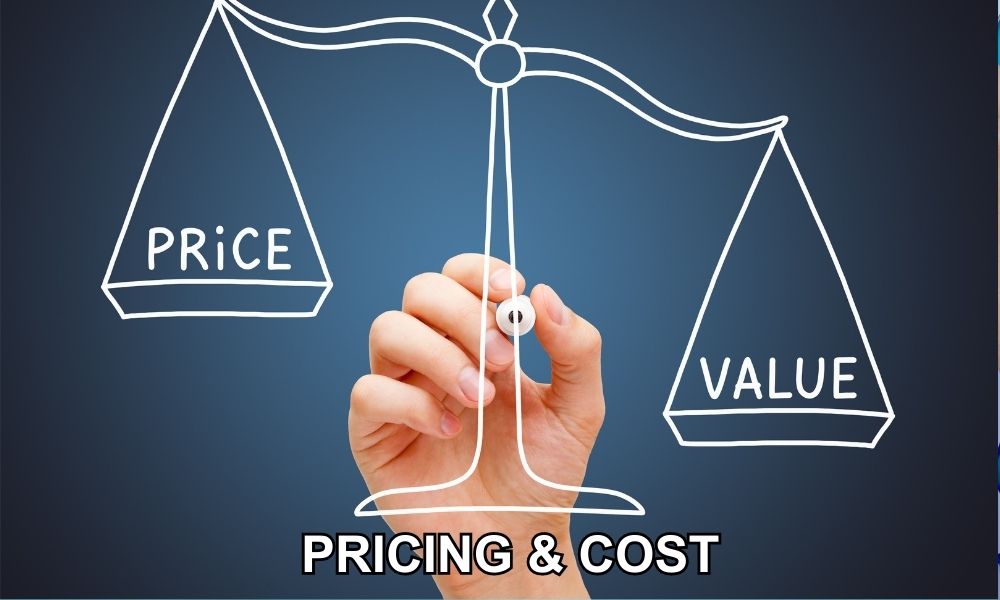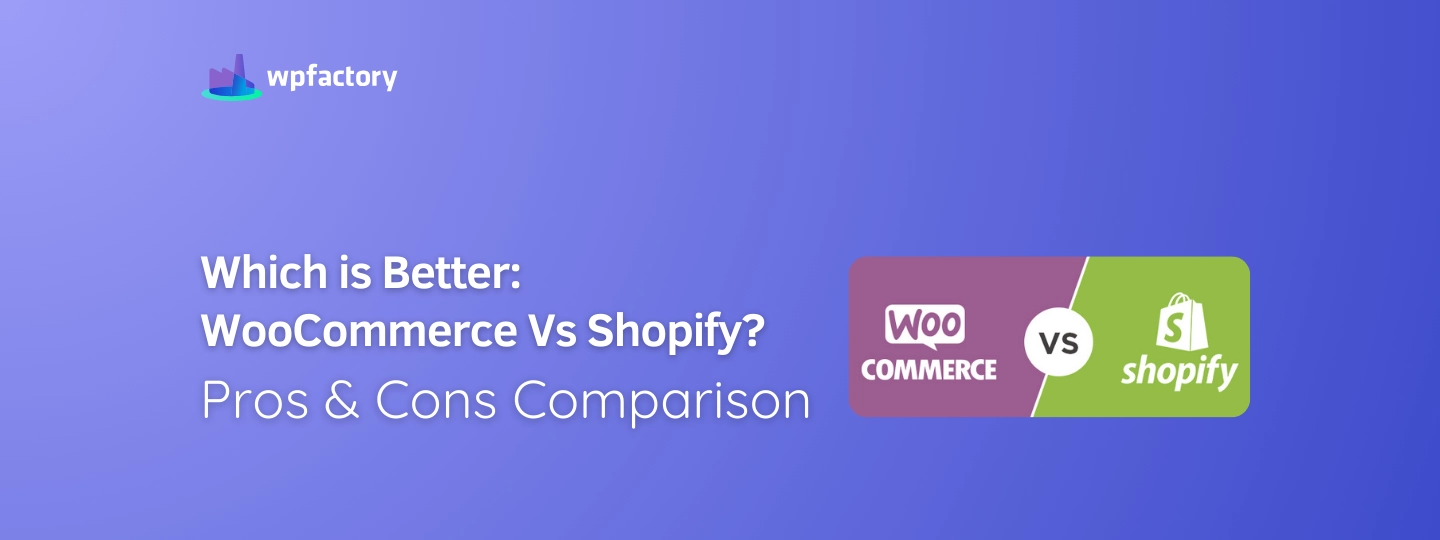Which is Better: WooCommerce vs Shopify? Pros & Cons Comparison
WooCommerce and Shopify are two of the most popular eCommerce Platforms. Often, new eCommerce store owners can be overwhelmed when choosing between the two.
Sometimes even existing store owners can be contemplating shifting from one platform to another. To help you decide which platform is suitable for your business, we have put together this stellar guide on WooCommerce vs Shopify.
In this article, we will thoroughly explore both platforms, going beyond the usual comparisons to uncover lesser-known factors that can have a significant impact on the success of your online store.
We will look at unconventional aspects to consider when evaluating the 2 platforms, going beyond the standard features and functionalities.
We will look at factors such as customizability and control, scalability beyond eCommerce, localization and global reach, design and user experience, marketing and consumer engagement, backend management and integration as well as pricing and cost analysis.
By exploring these unique perspectives, you’ll gain valuable insights to choose the platform that aligns with your specific business needs. This will help your online store stand out and succeed in the dynamic eCommerce landscape.
Unconventional Factors to Consider
You may have already come across several comparisons of WooCommerce and Shopify, usually, they will cover conventional factors only such as ease of use, number of plugins, cost, speed, etc. While these do make a difference, the real difference lies in unconventional factors, these are often overlooked yet they hold immense importance for long-term success.
1. Customizability and Control
For online stores, the ability to customize and exert control over their design and functionality significantly impacts your brand’s identity and customer experience. Both WooCommerce and Shopify offer customization options, however, it is important to explore the extent of control that they provide.
WooCommerce is an open-source platform built on WordPress, it offers unrivaled flexibility and customization possibilities. The key here is access to the underlying codebase, it gives you complete control over your store’s functionality, layout, and design. It’s therefore easy to leverage your development skills or hire a web developer to implement custom features, themes, and plugins that are tailor-made for your business. There is also a vast ecosystem for WooCommerce that offers an unparalleled range of plugins and themes that improve your store’s appearance and functionality.
Shopify on the other hand, takes a different approach with a hosted platform. You do get a robust set of themes and customization options through its theme editor, however, the level of access to the underlying codebase is limited. Instead, Shopify focuses on ease of use, allowing users to build eCommerce stores without a whole set of technical expertise. Shopify also has an app store that offers a wide range of apps and integrations that can extend the platform’s functionality to some extent.
Ultimately, the tradeoff between the two platforms is customizability and user-friendliness. While WooCommerce gives you complete control, you will need technical knowledge to accomplish that, Shopify prioritizes simplicity and user-friendliness.
On both platforms, if you want to customize beyond the “common” features in eCommerce, you’ll need to find technical talent on sites like Upwork. Alternatively, it’s better to hire a reliable development agency if you require ongoing improvements, here is an insightful guide to get you started.
2. Scalability Beyond eCommerce

Both Shopify and WooCommerce are primarily eCommerce platforms, however, as a business evolves it is likely to explore additional revenue streams and expand into new areas. It’s therefore important to consider the scalability of both platforms beyond traditional online selling.
WooCommerce is a WordPress plugin, therefore with the WordPress platform you get the advantages of seamless integration with various plugins and extensions beyond eCommerce.
This means it’s easy for you to leverage WordPress with its extensive ecosystem to transform your store into a website, a membership platform, a blog, an online course, or an LMS platform. You will just have to pick the right plugins and integrations to extend the functionality of your WooCommerce store, to scale your business beyond simple eCommerce.
Shopify is a hosted platform with its primary focus being eCommerce. However, it still provides scalability options, although it takes a more streamlined approach to scalability.
There are a range of integrated solutions and apps that can help you expand your business beyond physical or digital products. For example, you can use Shopify to launch a subscription-based service, dropshipping businesses, or even offline store retail operations. There are a wide variety of apps available on the Shopify App Store that support different business models and facilitate growth beyond eCommerce.
In summary, WooCommerce gives you the flexibility to customize and integrate additional functionalities to align with your evolving business needs, although it is resource intensive in terms of technical expertise and development resources. Shopify takes a simple and integrated approach to make it easier for you to explore new business models, albeit within the confines of the platform’s offerings.
3. Localization and Global Reach

It has never before been much easier to do business across borders. Expanding your business across borders and tailoring your eCommerce store for different locations is essential for growth. Therefore it’s useful to consider the localization and global reach of both platforms.
The plugin ecosystem of WooCommerce is the largest among all the content management systems. WooCommerce offers robust localization features such as support for multilingual websites and multiple currencies. Two of the most popular multilingual WordPress plugins are WPML (WordPress Multilingual) and Polylang.
There are also several multi-currency plugins. Some even have the ability to change your store’s currency based on the customer’s geolocation. Given the popularity of WooCommerce developers from all over the world are keen to develop for WooCommerce, and localized payment methods are available for almost any country.
Shopify also recognizes the importance of global reach and therefore comes with built-in localization features. It’s easy to create localized versions of your store by duplicating and translating your content, product descriptions, and checkout processes directly within the platform. Shopify also provides automatic currency conversions based on the visitor’s location.
When it comes to payment gateways, Shopify has a wide range of payment gateways that support global transactions, however, WooCommerce payment gateways easily outnumber Shopify’s payment gateways. Some payment gateways for Shopify also have stringent restrictions on sign-up processes and requirements, for example, Stripe, is mostly available in selected countries.
To determine the right platform for your business consider the scale of your international operations and the level of customization required for localization. If you want to target specific countries with tailored experiences, WooCommerce may be better, however, if you are looking for a user-friendly solution, Shopify’s built-in localization features offer convenience and efficiency.
Design and User Experience
The design and user experience of your online store play a pivotal role in driving conversions and setting you apart from the competition. Here are some aspects of design and user experience that you need to consider.
1. Branding Opportunities

A strong brand identity is crucial for creating a lasting impression on your customers. There are several branding opportunities offered by both platforms to help you establish a strong brand identity.
With WooCommerce you have complete control over the design elements, it allows you to create a website that truly reflects your brand’s personality. You get the ability to customize themes, templates, and layouts to align your online store with your brand’s colors, typography, and overall visual aesthetics. You can personalize every touchpoint of the customer’s journey from product pages to checkout ensuring a consistent and immersive brand experience.
Sometimes the number of themes available on for WooCommerce can be overwhelming, that’s why we have created this excellent guide on reviewing the best WooCommerce theme to make your life easier.
Shopify also offers a range of professionally designed themes that can be customized to align with your brand identity. These themes give you a solid foundation for showcasing your products and branding elements.
You can use Shopify’s theme editor to easily customize the colors font and layout of your website this gives you some flexibility to infuse your brand’s visual identity onto your website.
In addition to this Shopify offers advanced features such as custom domain names and email marketing integrations that further enhance your brand’s presence and recognition.
To choose between the two platforms you need to consider the unique elements that make your brand distinct. With WooCommerce you have the freedom to implement highly customized designs and features that truly represent your brand. Shopify on the other hand will provide the most streamlined approach to branding offering a range of professional themes and user-friendly customization options.
If you prefer to have extensive brand customization WooCommerce gives you the flexibility to create truly unique and immersive brand experiences. If you prefer a simpler yet polished approach to branding Shopify’s professionally designed themes and user-friendly customization options can help you establish a strong brand presence.
2. Accessibility and Inclusivity

Prioritizing accessibility and inclusivity is a great way to increase your customer base. In some countries, it is a legal requirement to have accessibility options on your website.
If you have accessibility options on your website, other than meeting this requirement, you also end up creating a welcoming and inclusive environment for potential customers who may have visual or hearing impairments, motor disabilities, or cognitive limitations.
Both WooCommerce and Shopify offer a range of features and resources to help you create a more accessible and inclusive online store.
WooCommerce comes with plugins such as alternative text for images, keyboard navigation, and complete control over color contrasts. WooCommerce also supports accessibility standards such as WCAG (Web Content Accessibility Guidelines), ensuring your online store meets the requirements for accessibility compliance.
Shopify also recognizes the importance of accessibility and inclusivity. The platform continuously works to improve accessibility features, aiming to create an inclusive experience for all users. Shopify’s themes undergo accessibility audits and improvements to ensure they meet industry standards.
Additionally, Shopify provides resources and guidelines for store owners to optimize their websites for accessibility, including recommendations for descriptive image alt tags, keyboard navigation, and accessible color schemes.
Whether you choose WooCommerce or Shopify, be sure to explore the accessibility features and guidelines provided by the platform. Consider consulting accessibility experts or conducting user testing to ensure your online store is accessible to the widest possible audience.
3. Innovative Design Trends

A visually compelling user experience helps you stay ahead of the curve by captivating your audience, enhancing engagement, and differentiating your online store from competitors. Here are some emerging design trends and how each platform supports them:
- Micro-interaction: Micro-interactions are subtle, interactive design elements that add depth and engagement to user interactions. They can include animations, hover effects, or visual feedback when users interact with buttons or elements on the website.
Both WooCommerce and Shopify provide options for implementing micro-interactions, whether through custom coding, theme customization, or the use of plugins and apps. If implemented correctly, micro-interactions can create a more interactive and delightful user experience. - Minimalism and Clean Design: Minimalism continues to be a popular design trend, emphasizing simplicity, clean layouts, and ample white space. Both platforms offer a wide range of theme customization options that incorporate minimalistic design principles. You can choose clean, uncluttered themes, use minimalist typography, and leverage a minimalist approach to product displays. Minimalism is great for creating sleek modern designs that result in a better user experience for your customers.
- Mobile-First Design: The number of people accessing the Internet and shopping online through their mobile phones has never been greater and it keeps increasing. Both WooCommerce and Shopify provide responsive themes and design options that ensure your online store looks and functions seamlessly across different screen sizes.
There are several mobile-friendly design features that are catered for by both platforms including touch-friendly navigation, quick loading times, and optimized checkout processes. Combined together, they provide a smooth user experience for your customers on their mobile devices. - Personalization and Dynamic Content: Tailoring the user experience to individual customers is a growing trend in eCommerce. WooCommerce and Shopify offer several tools and integrations for personalization, for example, displaying personalized product recommendations, targeted messaging, and dynamic content based on user behavior and preferences. A more personalized and engaging shopping experience for your customers can result in higher conversions for your store.

- Storytelling and Visual Storytelling: Connecting with customers through compelling narratives and visual storytelling is a powerful way to engage and build brand loyalty. Both WooCommerce and Shopify provide options to incorporate storytelling elements into your online store. This can be done through customizable content/tabs sections, video integration, or immersive product imagery. A carefully crafted brand story can result in a memorable and emotionally captivating experience for your customers.

Marketing and Customer Engagement
Effective marketing and customer engagement are two essential tools for the success of your online store. By understanding how each platform supports your marketing efforts, you can maximize your reach, attract the right customers, and create lasting relations with your customers.

1. Niche Marketing Strategies
Targeting a specific niche gives you distinct advantages over your competitors. When you focus on a niche market, you are able to cater to the unique needs and preferences of a segment of customers. This allows you to stand out from the crowd and build a loyal customer base. Here are some effective niche marketing strategies and how each platform facilitates the implementation of these strategies.
- Product Customizations: One effective niche marketing strategy is offering customizable products that cater to specific customer preferences or requirements. Both WooCommerce and Shopify give you the flexibility to create product options, configure custom fields, and offer personalized product variations. WooCommerce does this through plugins and Shopify does this through not only apps but themes as well that are designed for product configurations and customizations.
- Content Marketing and Blogging: Engaging with your niche audience through valuable content can help establish your store as an authority and build trust among your target customers. Both WooCommerce and Shopify allow you to leverage the power of blogging. With WooCommerce it’s through the WordPress CMS and with Shopify blogging is an integral part of the platform as well.
- Influencer and Affiliate Marketing: Collaborating with influencers and affiliates who have a strong presence and influence within your niche can help you reach a targeted audience effectively. Both WooCommerce and Shopify offer integrations with influencer marketing platforms and affiliate marketing apps. These integrations enable you to manage influencer and affiliate partnerships, track performance, and reward affiliates for driving sales within your niche market.
2. Customer Loyalty and Retention
Building customer loyalty is one of the best ways to ensure the long-term success of your online store. Customer loyalty can lead to repeat purchases and can generate positive word-of-mouth referrals and brand advocacy. Both platforms offer unique features to help you build customer loyalty and drive customer retention. Here are some unique strategies for building customer loyalty and how each platform supports these strategies.
- Loyalty Programs and Rewards: A loyalty program is a great way to incentivize customers to engage with your store, become repeat buyers, and strengthen their connection to your brand. Both WooCommerce and Shopify offer integrations with loyalty programs and apps that allow you to create any kind of a loyalty program for example, point accruals, exclusive discounts, referral rewards, and tiered membership levels.
- Exceptional Customer Service: Providing exceptional customer service is vital to building customer loyalty. WooCommerce and Shopify offer support for integrating customer service tools and chatbots to streamline communication and provide timely assistance. Additionally, both platforms allow customers to leave reviews and ratings, enabling you to actively respond to feedback and address customer concerns.
- Social Media Engagement: Engaging with customers on social media can build a sense of community amongst customers and help build brand loyalty. Both Shopify and WooCommerce allow you to connect your store to your social media profiles and provide seamless interactions for your customers. It’s easy to respond to comments, share user-generated content, and run social media-exclusive promotions.
Pricing and Cost Analysis
The cost of doing business can be the ultimate deciding factor when choosing a platform for your online store. It is crucial to make a decision that aligns with your budget and business goals.

1. Unconventional Cost Considerations
Often when comparing WooCommerce and Shopify, many people tend to simply compare the pricing plans of both platforms. However, it is important to take a deep dive and look into unconventional costs that may arise later on. These factors are often overlooked but critical and they can have a significant impact on your overall expenses and profitability.
WooCommerce offers great flexibility over your store’s design and functionality. However, this can sometimes come at an additional cost, in terms of technical development resources. WooCommerce will also require you to operate on a self-hosted platform hence you are responsible for finding a reliable web host and ensuring the security of your website. This gives you more control over hosting costs, but can easily result in proactive management.
Shopify on the other hand offers a more streamlined approach and an out-of-the-box solution, thereby potentially reducing development costs associated with customizations. When it comes to hosting, Shopify provides fully managed hosting, and the security of your website is also handled by Shopify. This makes it a more streamlined approach to hosting, however, it can sometimes be at a higher cost when compared to a self-hosted solution.
Third-party integrations on both platforms have costs associated with them. Some are free and some are paid and some offer a freemium model. The costs for these integrations can vary depending on your requirements. You will need to evaluate the specific integrations and apps you require for your store and consider their costs to ensure they align with your budget.
There are also payment gateways and transaction fees that are a critical aspect of an eCommerce store. Both WooCommerce and Shopify have multiple payment gateways, but transaction fees may apply depending on the payment provider that you choose. The key consideration here is to evaluate how the transaction fees align with your projected sales volume and profitability.
The total cost of ownership, including subscription fees, transaction fees, hosting costs, and additional expenses needs to be considered when evaluating which platform to use.
2. Value for Money
Determining the value for money offered by an eCommerce platform can be tricky. Price is an important factor for consideration, however, it is equally important to assess the other value-for-money factors that both platforms offer. Here are two key factors that add value to your overall experience on both platforms.
- Scalability and Performance: A key aspect to consider when looking at value for money is how well the platform can accommodate your business growth and deliver optimal results. For WooCommerce, the scalability will depend on your hosting resources and optimization efforts. This allows you to scale your store as needed.
This is a great advantage to have for rapidly growing businesses. Shopify meanwhile is a fully managed solution with built-in scalability and performance, it allows you to seamlessly handle increasing traffic and sales.
While both platforms are suitable for growing businesses, you need to assess your growth projections and the importance of hassle-free scalability to get an understanding of the value offered by both platforms. - Support and Resources: The availability of support and resources can greatly impact your experience and the value you derive from the platform. WooCommerce boasts a vast community of developers, designers, and users who actively contribute to plugins, themes, and knowledge.
This extensive community support can provide valuable assistance and resources when needed. Shopify, on the other hand, offers dedicated customer support and a well-documented knowledge base, ensuring you have access to reliable assistance throughout your eCommerce journey.
Conclusion
In conclusion, both WooCommerce and Shopify offer robust e-commerce solutions with unique strengths and considerations. WooCommerce provides greater flexibility, customization options, and control over your online store, making it suitable for businesses seeking extensive customization and scalability. Shopify offers a streamlined, user-friendly experience with built-in scalability, making it ideal for businesses seeking a hassle-free, all-in-one solution.
Ultimately, the best choice between WooCommerce and Shopify depends on your specific business needs, budgetary considerations, growth projections, and customization preferences. Take the time to evaluate each platform based on the criteria outlined in this article, and consider seeking expert advice or consulting with professionals if needed.







